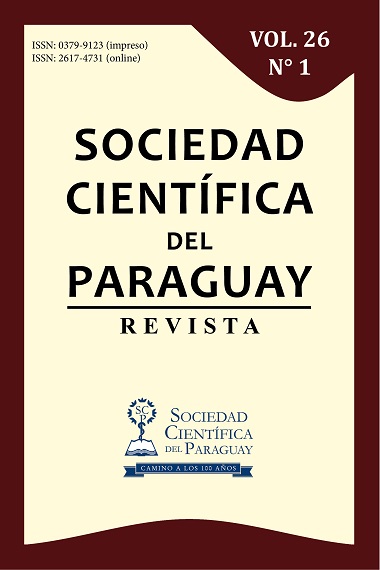Population density of Meloidogyne graminicola in commercial rice plantations and behavior of advanced lines in the province of Los Ríos, Ecuador
DOI:
https://doi.org/10.32480/rscp.2021.26.1.64Keywords:
rice, advanced lines, Meloidogyne graminicola, Oryza rufipogon, sustainable managementAbstract
Populations of Meloidogyne graminicola in commercial rice plantations in Ecuador and resistance of F5 rice lines derived from interspecific crosses of Oryza sativa L. ssp. japonica x Oryza rufipogon G. (PUYÓN) and from intraspecific crosses from Oryza sativa L. ssp. japonica lines to the M. graminicola were determined. Population density evaluations were conducted on roots and soil of rice sampled from 20 commercial plantation areas while resistance research was assessed under controlled nursery conditions. A total of 50 advanced F5 rice lines were inoculated with 2,500 J2 M. graminicola with a commercial variety, INIAP 15, susceptible to the attack of M. graminicola. Results showed remarkably high incidence of M. graminicola in 13 out of 20 investigated plantation areas. Response to M. graminicola among the inoculated 50 advanced Lines F5 showed that four (4) Lines 32 (PUYÓN / JP002 P11 - 10 P74), 5 (PUYÓN / JP002 P8 - 20 P13), 31 (PUYÓN / JP002 P11 - 10 P22) and 2 (PUYÓN / JP002 P8 - 20 P14) presented a low population density of M. graminicola / 10 g of roots. Analysis on Reproduction index showed that the least number of times the nematode multiplied was 2 times in Line 32 (PUYÓN / JP002 P11 - 10 P22) while more than 2 times in the other lines. In conclusion, F5 line from interspecific crosses of Oryza sativa L. ssp. japonica x Oryza rufipogon G. (PUYÓN) has quantitative nematode resistance with Line 32 (PUYÓN / JP002 P11-10 P74) had the lowest nematode attack, suggesting that this line is promising for crop production in nematode prevalent areas. Studies assessing the production performance of these F5 rice lines in the very high nematode identified areas and measures to control the prevalence of nematodes are recommended.
Metrics
Downloads
References
2. Velásquez V. Economic, social and political analysis of the agri-food chain of rice in Ecuador, period 2005-2014. Dissertation prior to obtaining the title of Economist. Catholic University of Ecuador. Faculty of Economics, Quito-Ecuador. 2016:143.
3. Díaz D, Chaparro A. Methods and agricultural uses of genetic engineering applied to rice. Rev. Colomb. Biotecnol. 2012;14(2):179-195.
4. Franquet J. Varieties and rice improvement. In: Universitat Internacional de Catalunya. 2004. 157:199. (in Spanish)
5. Acevedo M, Castrillo W, Belmonte U. Origin, evolution, and diversity of rice. Agronomía Trop. 2006;56(2):151-170.
6. Bridge J, Star J. Plant nematodes of agriculture importance: A color Handbook Migratory Endoparasite. Londres. Academic Press. 2007;57- 59.
7. Soriano I, Prot J, Matias D. Expression of tolerance for Meloidogyne graminicola in rice cultivars as affected by soil type and flooding. Journal of Nematology.2000; 32(3):309 - 317.
8. Talavera M. Manual de Nematologia Agrícola. Introducción al análisis y al control nematológico para agricultores y técnicos de agrupaciones de defensa vegetal. 2003;23. Available in: http://www.caib.es/sacmicrofront/archivopub.do?ctrl=CNTSP722ZI4569&id=4569
9. Institute of Agricultural and Fisheries Research and Training. (SERVIFAPA). Integrated Management of Phytoparasite Nematodes in Horticultural Crops. Editors: Board of Santa Lucia. Spain. 2014, 120 p.
10. INAMHI. National Institute of Meteorology and Hydrology. Agrometeorology Station of the Faculty of Agricultural Sciences of the Technical University of Babahoyo, Los Ríos, Ecuador; 2019.
11. Triviño C, Navia D, Velasco L. Guide to recognizing root damage and methods of sampling and extraction of nematodes in roots and soil. Yaguachi, Ecuador. Autonomous National Agricultural Research Institute. Litoral Sur Experimental Station "Dr. Enrique Ampuero Pareja". Disclosure Bulletin. 2013;43:3-17.
12. Ramos J, Franco J, Ortuño N, Oros R, Main G. Incidence and Severity of Nacobbus aberrans and Globodera spp. in the cultivation of potatoes in Bolivia: losses in the gross value of its production. Cochabamba, Ibta/Proimpa. 1998;201.
13. Bridge J, Page S. The rice root-knot nematode, Meloidogyne graminicola, on deep water rice (Oryza sativa L. ssp. indica). Revue de Nématologie. 1982;5:225–232
14. Padgham J, Duxbury J, Mazid A, Abawi G, Hossain H. Yield los caused by Meloidogyne graminicola on low-land rainfed rice in Bangladesh. J Nematol. 2004;36:42-48.
15. Triviño C, Navia F, Velasco L. Plant – Parasitic Nematodes Associated with rice in Ecuador. Nematropica. 2016;46(1):45-53
16. Hettwer K, Jähne M, Frost K, Giersberg M, Kunze G, Trimborn M, Reif J Türk M Gehrmann L, Dardenne F. Validation of Arxula Yeast Estrogen Screen assay for detection of estrogenic activity in water samples: results of an international interlaboratory study. Sci. Total Environ. 2018;621:612-625.
17. Reyes I. Determination of the susceptibility of forty rice materials (Oryza sativa L.) to Meloidogyne graminicola. Agricultural Engineer thesis. Technical University of Babahoyo. Ecuador. Faculty of Agricultural Sciences. 2013:21.
Downloads
Published
Issue
Section
License
El/los autores autorizan a la Revista de la Sociedad Científica del Paraguay a publicar y difundir el articulo del cual son autores, por los medios que considere apropiado.


















